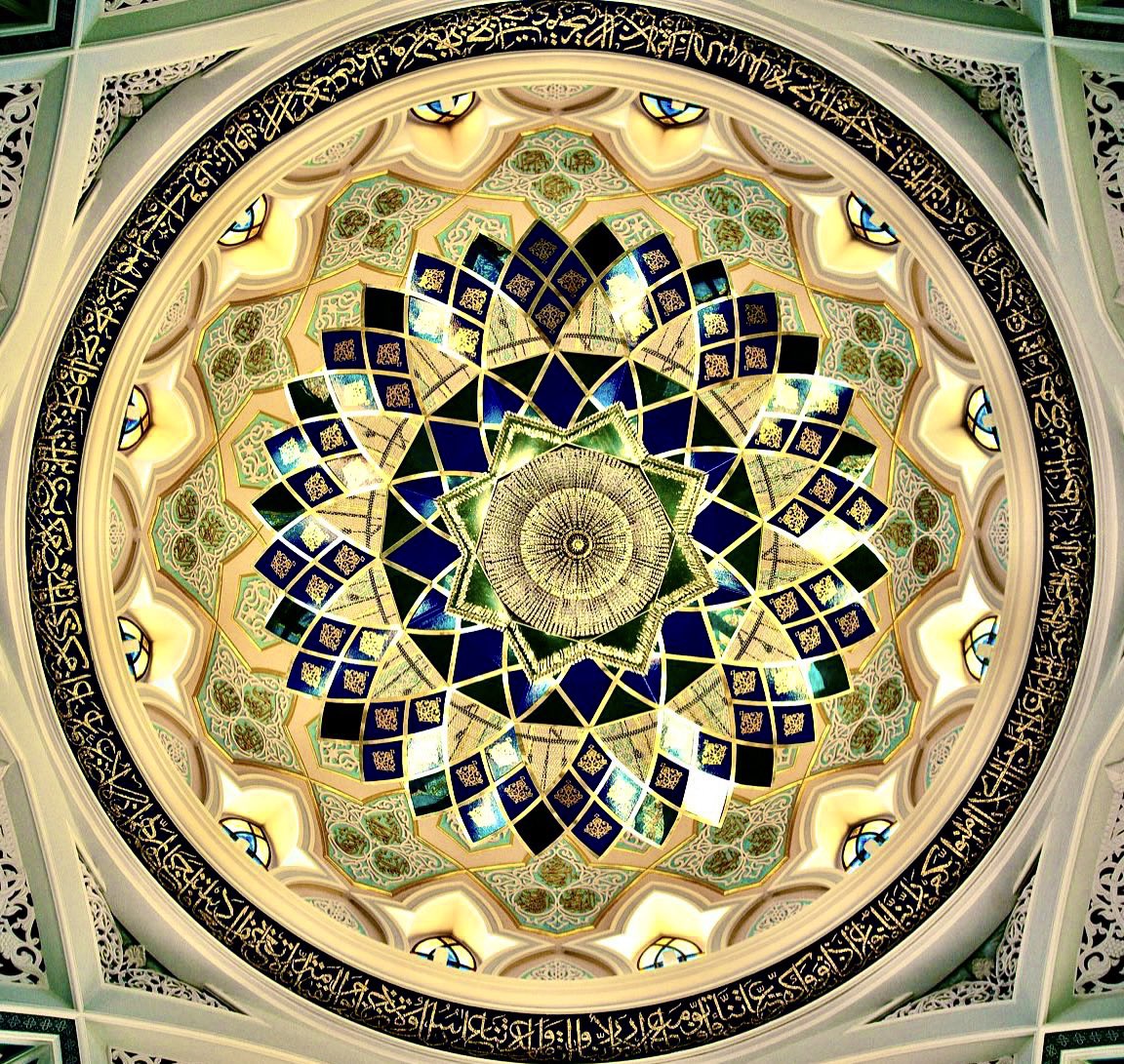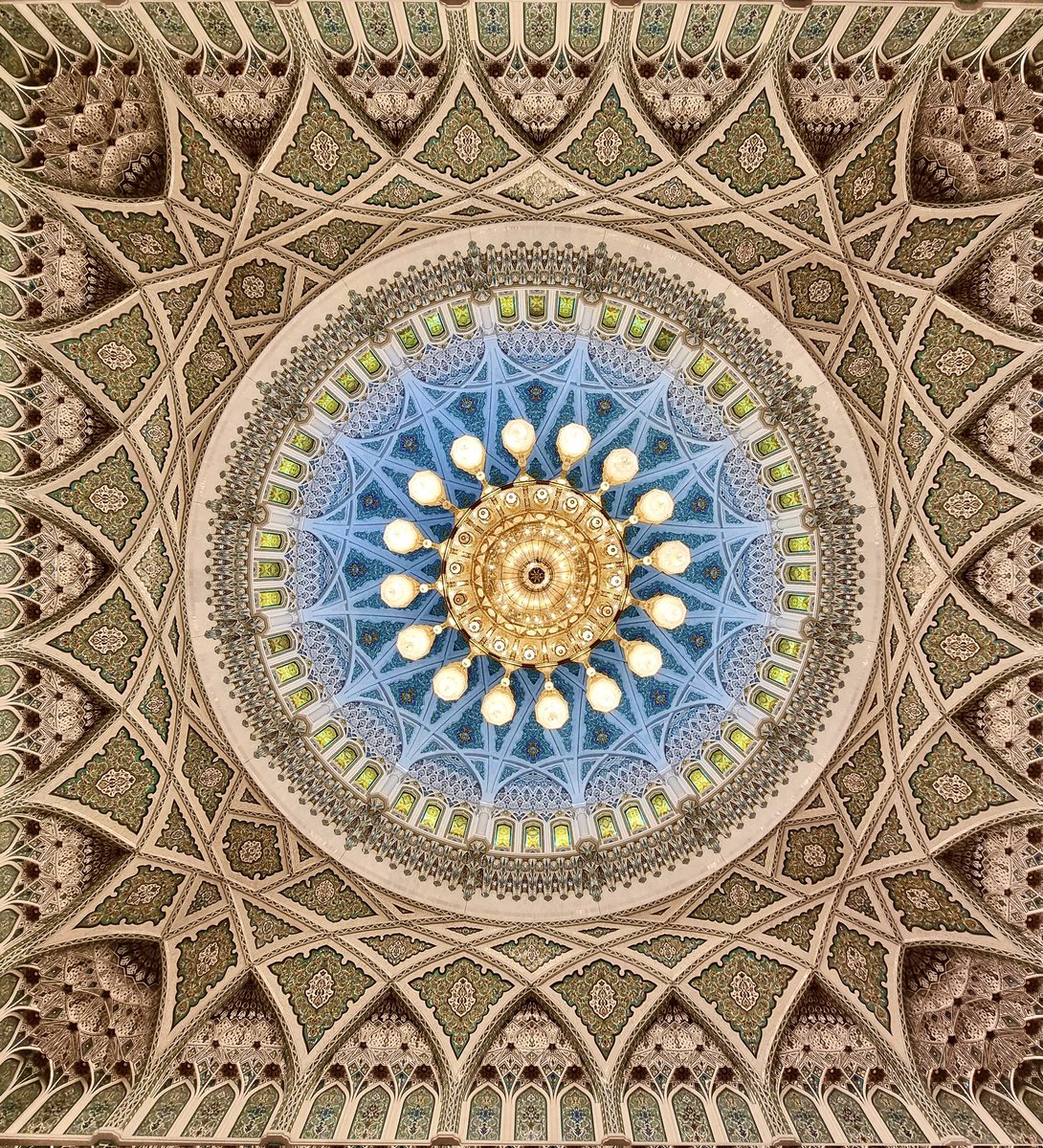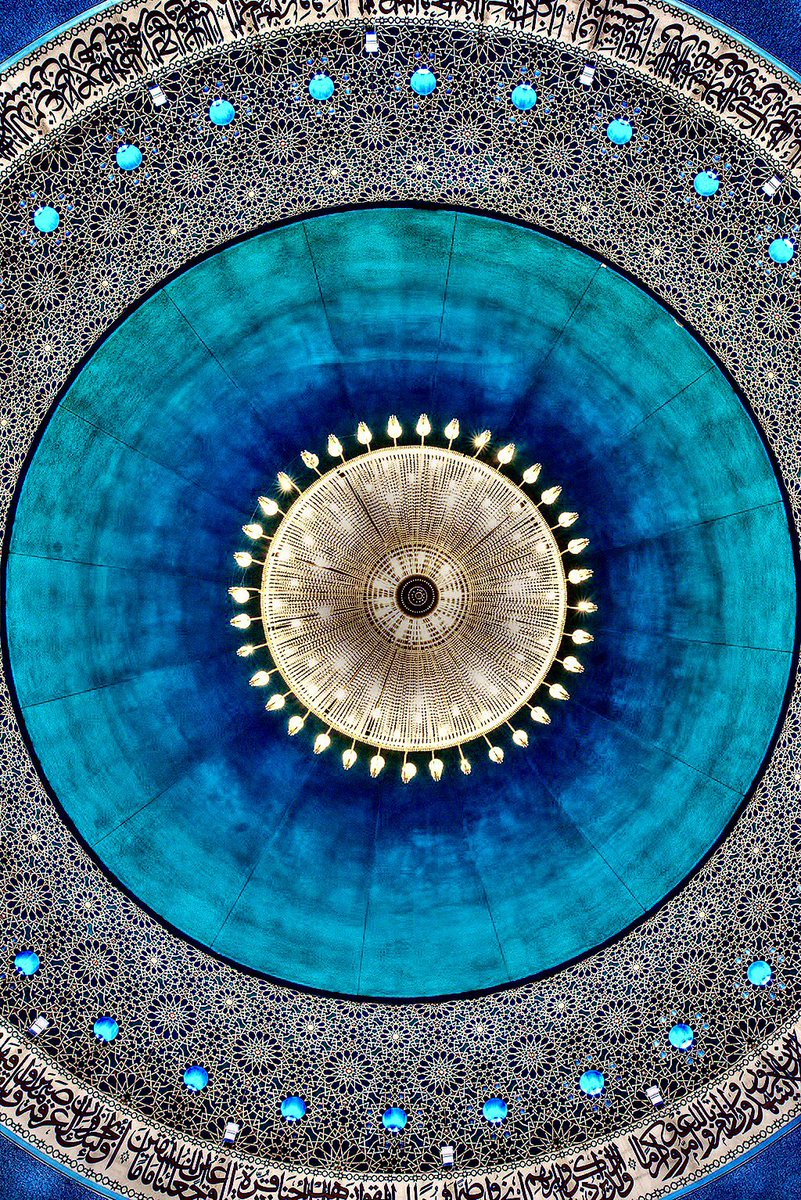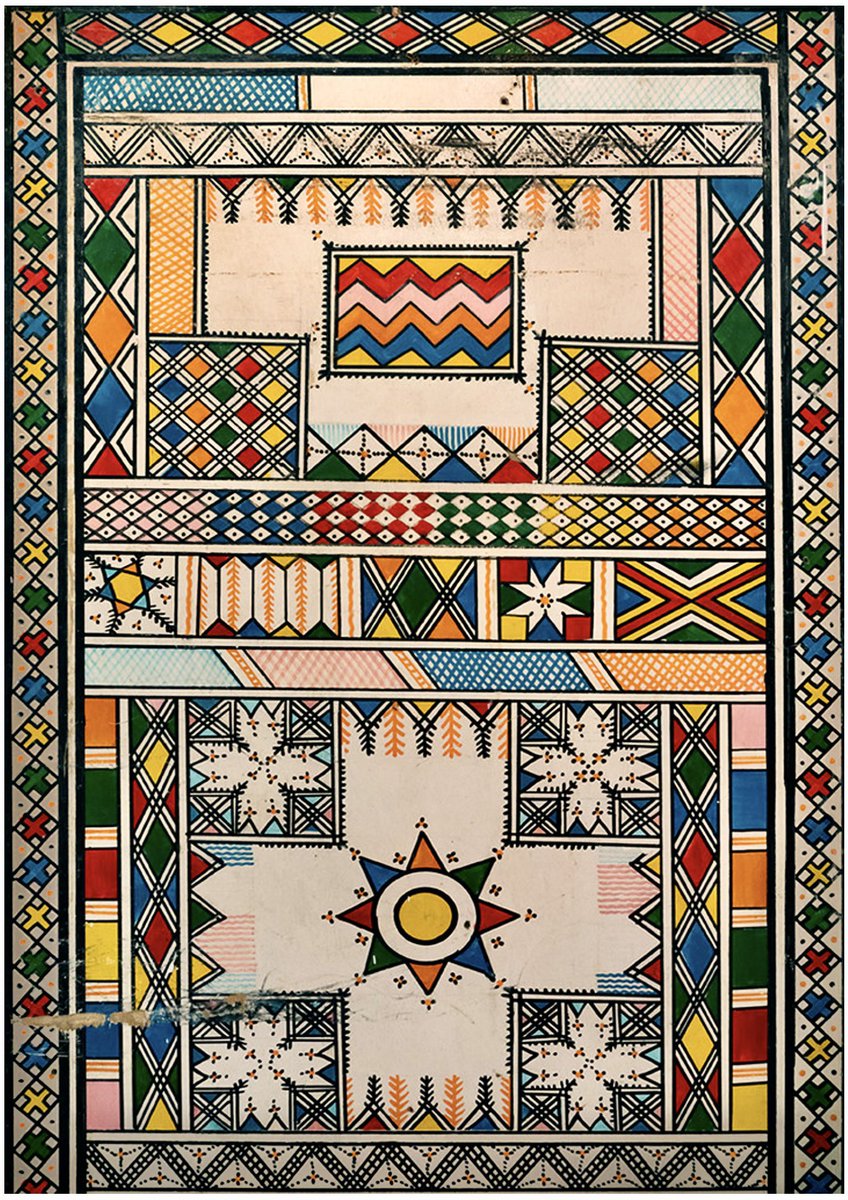
Most mosques feature a dome, called qubba in Arabic. The dome is a symbolic representation of the vault of heaven. The interior decoration of a dome often emphasises this symbolism using patterns to awe & inspire
Here are 24 dome interiors in mosques across the world
A thread…
Here are 24 dome interiors in mosques across the world
A thread…

1/ Dome interior of Hafez Tomb, Shiraz, Iran
Built in 1773 in memory of the celebrated Persian poet Hafez. The open pavilion structures are situated in the Musalla Gardens on the north bank of a seasonal river and house the marble tomb of Hafez
Built in 1773 in memory of the celebrated Persian poet Hafez. The open pavilion structures are situated in the Musalla Gardens on the north bank of a seasonal river and house the marble tomb of Hafez

2/ Dome interior of The Putra Mosque, Putrajaya, Malaysia
Building began in 1997 & completed two years later. The pink-domed Mosque is constructed with rose-tinted granite & includes a prayer hall, courtyard & learning facilities. The mosque can accommodate 15,000 worshippers
Building began in 1997 & completed two years later. The pink-domed Mosque is constructed with rose-tinted granite & includes a prayer hall, courtyard & learning facilities. The mosque can accommodate 15,000 worshippers

3/ Dome interior of Al-Ashrafiya Mosque, Taiz, Yemen
Considered to be one of the most important centers in the Islamic history of Yemen. It was supposedly built in two stages: by Sultan Al-Ashraf Umar II (1295-6), by Sultan Al-Ashraf Isma'il I (1377-1400) and opened in 1382
Considered to be one of the most important centers in the Islamic history of Yemen. It was supposedly built in two stages: by Sultan Al-Ashraf Umar II (1295-6), by Sultan Al-Ashraf Isma'il I (1377-1400) and opened in 1382

4/ Dome interior of Nur Astana Mosque, Kazakhstan
The third largest mosque in Central Asia. The 40-meter height symbolizes the age of Prophet Muhammad (PBUH) when he received the revelations, and the height of the minarets are 63 meters, the age when he died
The third largest mosque in Central Asia. The 40-meter height symbolizes the age of Prophet Muhammad (PBUH) when he received the revelations, and the height of the minarets are 63 meters, the age when he died

5/ Dome interior of Al-Aqsa Mosque, Jerusalem, Palestine
In the Old City of Jerusalem, the 3rd holiest site in Islam. It was built on top of the Temple Mount, known as the Al Aqsa Compound or Haram esh-Sharif in Islam, several decades after Prophet Muhammad's (PBUH) death
In the Old City of Jerusalem, the 3rd holiest site in Islam. It was built on top of the Temple Mount, known as the Al Aqsa Compound or Haram esh-Sharif in Islam, several decades after Prophet Muhammad's (PBUH) death

6/ Dome interior of Mazari Sharif, Afghanistan
Many Afghanis believe Ali ibn Abi Talib is buried here. The building gives the city, Mazari Sharif (meaning "Tomb of the Exalted") its name. The shrine was erected here in 1136 and the interior ceiling is a splendour of colour
Many Afghanis believe Ali ibn Abi Talib is buried here. The building gives the city, Mazari Sharif (meaning "Tomb of the Exalted") its name. The shrine was erected here in 1136 and the interior ceiling is a splendour of colour

7/ Dome interior of Kul Sharif Mosque, Kazan, Tatarstan
Originally, the mosque was built in the Kazan Kremlin in the 16th century. It was named after Kul Sharif, who was a religious scholar who served there
Originally, the mosque was built in the Kazan Kremlin in the 16th century. It was named after Kul Sharif, who was a religious scholar who served there

9/ Dome interior of Sheikh Lotfollah Mosque, Naqsh-i Jahan Square, Esfahan, Iran
Construction of the mosque started in 1603 and was finished in 1619. Built by the chief architect Mohammadreza Isfahani, during the reign of Shah Abbas I of Persia
Construction of the mosque started in 1603 and was finished in 1619. Built by the chief architect Mohammadreza Isfahani, during the reign of Shah Abbas I of Persia

10/ Dome interior of At-Taqwa Mosque, Cirebon, West Java, Indonesia
Taqwa Grand Mosque is a historical mosque in the city of Cirebon, West Java, founded in 1918. Today it is one of the congregational mosques in Cirebon and considered an icon of the city
Taqwa Grand Mosque is a historical mosque in the city of Cirebon, West Java, founded in 1918. Today it is one of the congregational mosques in Cirebon and considered an icon of the city

11/ Dome interior of Nasir al Mulk Mosque. Shiraz, Iran
Nasir al-Mulk Mosque was constructed between 1876 and 1888, during the Qajar dynasty, which ruled Iran from 1785 to 1925. It has been dubbed the “Pink Mosque” due to the plethora of pink-colored tiles blanketing the ceiling
Nasir al-Mulk Mosque was constructed between 1876 and 1888, during the Qajar dynasty, which ruled Iran from 1785 to 1925. It has been dubbed the “Pink Mosque” due to the plethora of pink-colored tiles blanketing the ceiling

12/ Dome interior of The Shah Jahan Mosque, Thatta, Pakistan
Also known as the Jamia Masjid of Thatta, is a 17th-century building that serves as the central mosque for the city of Thatta, in the Pakistani province of Sindh.
Also known as the Jamia Masjid of Thatta, is a 17th-century building that serves as the central mosque for the city of Thatta, in the Pakistani province of Sindh.

13/ Dome interior of Sultan Qaboos Grand Mosque, Oman
In 1992, Qaboos bin Said al Said, the then Sultan of Oman, directed that his country should have a Grand Mosque, construction commenced in December 1994. The chandelier above the praying hall is 14 metres (46 feet) tall
In 1992, Qaboos bin Said al Said, the then Sultan of Oman, directed that his country should have a Grand Mosque, construction commenced in December 1994. The chandelier above the praying hall is 14 metres (46 feet) tall

14/ Dome interior of Tokyo Mosque (東京ジャーミイ), Ōyama-chō district of Shibuya ward in Tokyo, Japan
The largest mosque in Japan. Originally built in 1938, the current building was completed in 2000. It was designed by Hilmi Senalp in a style inspired by Ottoman architecture
The largest mosque in Japan. Originally built in 1938, the current building was completed in 2000. It was designed by Hilmi Senalp in a style inspired by Ottoman architecture

15/ Dome interior of Juma Mosque, Tashkent, Uzbekistan
Also known as the Jama or Dzhuma Mosque, it was built in 1451 by Sheikh Ubaydullo Khoja Akhror (1404-1490).
Also known as the Jama or Dzhuma Mosque, it was built in 1451 by Sheikh Ubaydullo Khoja Akhror (1404-1490).

16/ Dome interior of Al-Masjid an-Nabawi Masjid, Medina, Saudi Arabia
Built by Prophet Muhammad (PBUH) it was the 2nd mosque built in Medina after Masjid Quba' & is the second largest mosque and second holiest site in Islam, both titles ranking after the Masjid al-Haram in Mecca
Built by Prophet Muhammad (PBUH) it was the 2nd mosque built in Medina after Masjid Quba' & is the second largest mosque and second holiest site in Islam, both titles ranking after the Masjid al-Haram in Mecca

17/ Dome interior of Malek Mosque, Kerman, Iran
The mosque was built at the time of Turan Shah I, Kerman Seljuk Sultanate, in the 11th century. This mosque is the biggest and oldest mosque in Kerman.
The mosque was built at the time of Turan Shah I, Kerman Seljuk Sultanate, in the 11th century. This mosque is the biggest and oldest mosque in Kerman.

18/ Dome interior of Shahi Mosque Chiniot, Pakistan
A historic 17th century mosque located in Chiniot, Punjab. It was built under supervision of Mughal Grand Vizier Saadullah Khan
A historic 17th century mosque located in Chiniot, Punjab. It was built under supervision of Mughal Grand Vizier Saadullah Khan

19/ Dome interior of the Selimiye Mosque, Edirne, Turkey
An Ottoman imperial mosque commissioned by Sultan Selim II, it was built by the imperial architect Mimar Sinan between 1568 and 1575. It was considered by Sinan to be his masterpiece.
An Ottoman imperial mosque commissioned by Sultan Selim II, it was built by the imperial architect Mimar Sinan between 1568 and 1575. It was considered by Sinan to be his masterpiece.

20/ Dome interior of Salahuddin Abdel Aziz Shah Mosque,
Selangor, Malaysia
It is the country's largest mosque and also the second largest mosque in Southeast Asia by capacity. Its most distinguishing feature is its large blue and silver dome
Selangor, Malaysia
It is the country's largest mosque and also the second largest mosque in Southeast Asia by capacity. Its most distinguishing feature is its large blue and silver dome

21/ Dome interior of Tilla Kari, Uzbekistan
Built in 1646, "Madrasah of gold" is the literal translation of "Tilla-Kari." It was given this name because the facades of the madrasah and the mosques are covered with gilding made in the unusual technique called "kundal
Built in 1646, "Madrasah of gold" is the literal translation of "Tilla-Kari." It was given this name because the facades of the madrasah and the mosques are covered with gilding made in the unusual technique called "kundal

22/ Dome interior of Al-Salam Mosque, Homs, Syria
It was designed by architect Shawki Tawokkol and construction was completed in 1980, partially with the support of local volunteers
It was designed by architect Shawki Tawokkol and construction was completed in 1980, partially with the support of local volunteers

23/ Dome interior of Sultan Mehmet Fatih Mosque, Pristina, Kosovo
The Imperial Mosque also known as is an Ottoman mosque was built in 1461 by Sultan Mehmet II Fatih. The mosque was declared a Monument of Culture of Exceptional Importance in 1990 by the Republic of Serbia.
The Imperial Mosque also known as is an Ottoman mosque was built in 1461 by Sultan Mehmet II Fatih. The mosque was declared a Monument of Culture of Exceptional Importance in 1990 by the Republic of Serbia.

24/ Dome interior of Sepahsālār Mosque, Tehran, Iran
Built in 1879-1884. One of the largest Mosque in Tehran. During the late Qajar as well as Pahlavi era, Sepahsalar mosque was distinctive landmark of Tehran with its eight minarets which was unique in Persian design of mosques
Built in 1879-1884. One of the largest Mosque in Tehran. During the late Qajar as well as Pahlavi era, Sepahsalar mosque was distinctive landmark of Tehran with its eight minarets which was unique in Persian design of mosques

• • •
Missing some Tweet in this thread? You can try to
force a refresh



















